|
|
In the process of writing the previous post, I learned about Libya's Great Man-Made River, "an enormous, long-term undertaking to supply the country's needs by drawing water from aquifers beneath the Sahara and conveying it along a network of huge underground pipes."     [Images: The concrete skeleton of Libya's future river, the "8th wonder of the world," being trucked into place; photographed by Jaap Berk]. [Images: The concrete skeleton of Libya's future river, the "8th wonder of the world," being trucked into place; photographed by Jaap Berk].Not only does Libya bear the distinction of holding the world record for hottest recorded temperature ( 136º F), but most of the country's terrain is " agriculturally useless desert" that receives little or no rainfall. The Great Man-Made River may not even successfully irrigate Libya's governmentally-specified agricultural zones, but due to the region's complete " absence of permanent rivers or streams" – and because the country's "approximately twenty perennial lakes are brackish or salty" – the River's expected 50-100 year lifespan is at least a start. Indeed, Libya's "limited water is considered of sufficient importance to warrant the existence of the Secretariat of Dams and Water Resources, and damaging a source of water can be penalized by a heavy fine or imprisonment." George Orwell would perhaps call this watercrime.  However, I have to say that the prospect of spelunking through the Great Man-Made River's subterranean galleries in 125 years, once those tunnels have dried-up, makes the brain reel. Imagine Shelleys of the 22nd century wandering through those ruins, notebooks in hand, taking photographs, footsteps echoing rhythmically beneath the dunes as they walk for a thousand kilometers toward the sea...  Yet some are skeptical of the project's real purpose. Precisely because the Great Man-Made River consists of "a stupendous network of underground tunnels and caverns built with the help of Western firms to run the length and width of the country," some consultants and engineers " have revealed their suspicion that such facilities were not meant to move water, but rather to conceal the movement and location of military-related activities." The fact that water is flowing through some of the pipes, in other words, is just an elaborate ruse... In any case, the Great Man-Made River Authority – "entrusted with the implementation and operation of the world's largest pre-stressed concrete pipe project" – is already seeing some results. The network will criss-cross most of the country –  – and Phase III is under construction even as this post goes online. Meanwhile, for more information on deep desert hydrology see UNESCO's International Hydrological Programme or even Wikipedia. Of course, you could also turn to J.G. Ballard, whose twenty year-old novel The Day of Creation is: 1) not very good, and 2) about a man who is "seized by the vision of a third Nile whose warm tributaries covered the entire Sahara." That river will thus "make the Sahara bloom." The book was modestly reviewed by Samuel Delany, if you want to know more. On the other hand, I would actually recommend Dune – assuming you like science fiction.  [Image: A new river is born, excavated from the surface of the desert: soon the pipes will be installed and the currents will start to flow...]. [Image: A new river is born, excavated from the surface of the desert: soon the pipes will be installed and the currents will start to flow...].
 [Image: A satellite view of "two huge sand dune seas in the Fezzan region of southwestern Libya." These are "sprawling seas of multi-storey sand dunes known as 'ergs'. The Erg Ubari (also called Awbari) is the reddish sand sea towards the top of the image. A dark outcrop of Nubian sandstone separates the Erg Ubari sand from the Erg Murzuq (also called Murzuk) further south." See earlier for more satellite imagery].
"A mediaeval cathedral was a sort of permanent and unchangeable TV programme that was supposed to tell people everything indispensable for their everyday life, as well as for their eternal salvation." So says Umberto Eco, speaking at the Bibliotheca Alexandrina, Egypt, 2003.  [Image: Cathedral at Bourges, by Arnaud Frich]. [Image: Cathedral at Bourges, by Arnaud Frich].This makes me wonder if everyone on Earth could take everything they know and carve it into a cliffside somewhere – or a mountain – sculpting all that rock into a cathedral; and, then, if they could take that hulking monolith of information and minerals and break it off, launch it into orbit, send it drifting through space... It'd be a kind of moving table of contents for the human species. A knowledge-object. Would that have a better chance than NASA's so-called Golden Record, that got sent out with Voyager, of explaining the Earth and human history to distant civilizations?  [Image: NASA's Golden Record, "intended to communicate a story of our world to extraterrestrials." The record is really "a 12-inch gold-plated copper disk containing sounds and images selected to portray the diversity of life and culture on Earth," including the sound of "surf, wind and thunder, birds, whales, and other animals," and a signed letter from then-president Jimmy Carter. A Menudo video was reportedly removed at the last minute]. [Image: NASA's Golden Record, "intended to communicate a story of our world to extraterrestrials." The record is really "a 12-inch gold-plated copper disk containing sounds and images selected to portray the diversity of life and culture on Earth," including the sound of "surf, wind and thunder, birds, whales, and other animals," and a signed letter from then-president Jimmy Carter. A Menudo video was reportedly removed at the last minute].Or, instead of demolishing old buildings, perhaps we should detach them from the Earth's surface and send them into space as lessons for alien species. Like that Michael Crichton novel. You could learn about the Earth by studying its architecture – because the planet flings buildings everywhere. Constantly. Archipelagoes of abandoned shopping malls pulled slowly toward distant planets. There goes the Mall of America... A new film directed by Jerry Bruckheimer.
Two different myths are set to collide in space as NASA's THOR project targets the surface of Mars with a huge copper sphere.  "The idea behind THOR (Tracing Habitability, Organics, and Resources) is to fly an observer spacecraft to Mars and, hours before it reaches the planet, release an 'impactor' ball. It could be up to 230 kilograms in mass and would be aimed at a region about 40° north or south of the equator." While thus testing the Martian landscape for signs of water, THOR is nothing less than "a brute force way to gain access to the subsurface of Mars." So BLDGBLOG is now taking bets: Mars triumphant or Thor planet-slayer, destroyer of worlds...? Which myth will win?
Russia, we read has "plans to build a permanent base on the Moon within a decade and to start mining the planet for helium 3, a sought-after isotope, by 2020."  "Russian scientists have come up with the idea of using 'lunar bulldozers' to heat the Moon's surface in order to get at the resource," adding that "Moscow is keen to institute regular cargo flights of helium 3 back to Earth as soon as possible." 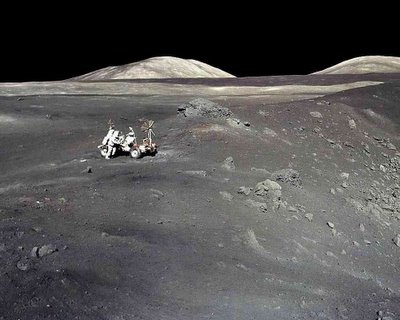 If you'll pardon a lengthy quotation: "'There are practically no reserves of helium 3 on Earth. On the Moon, there are between one million and 500 million tons, according to estimates.' Much of those reserves are reported to be in the Sea of Tranquillity. [Nikolai Sevastyanov, of Energia Space Corporation] predicted that nuclear reactors capable of running on helium 3 would soon be developed and said that just one ton of the isotope would generate as much energy as 14 million tons of oil. 'Ten tons of helium 3 would be enough to meet the yearly energy needs of Russia,' he added. However, Russia is not the only country interested in the technology. American scientists have expressed interest in helium 3, arguing that one shuttle-load of the isotope would be sufficient to meet US electrical energy needs for a year." So: from the Red Sea to the Sea of Tranquillity – what future lunar wars may bring...  [Image: An unrelated example of a helium 3 mining unit from the Lunar Base Design Workshop. "Mining itself is done by robots that scoop up lunar regolith for processing. This base consists of three spheres that roll, with the structure moving from site to site."] Earlier on BLDGBLOG: Lunar urbanism 4.
Through her job with the Benjamin Franklin Tercentenary, BLDGBLOG contributor Nicola Twilley has put together something that should hopefully get more people thinking about urban design, sustainability, quality of life, public transport, pedestrianization... Whatever sounds good. And though BLDGBLOG is not involved, I thought I'd give it a plug here, and try to drum up some interest.  In a nutshell, the program is called the Ben Franklin Coffeehouse Challenge, and it's sponsored by Starbucks. The idea is that you get some people together, discuss something you'd like to see happen in your community – more benches, a new park, some fresh paint on the neighborhood bus stop, a film society, a mural or two, a NASCAR track, fewer potholes, some roof gardens, a new running path – meet a few more times to refine the idea, then you organize it into a coherent, workable plan. That plan is then submitted to the Tercentenary, who review it with a panel of urban designers, community groups, etc. – and if whatever magical buttons need to be pushed are pushed, then Starbucks will give you $3000 and you can get the project off the ground. That's right: cash money. It's all about the Benjamins. For now, though, it's only in Greater Philadelphia (with south Jersey up to Princeton, parts of Delaware, and central PA all the way to Penn State included, hint-hint) – but I'm sure you could convince everyone involved that the desire for urban improvement is nationwide. Park benches in Minneapolis, roof gardens in San Francisco, running paths in Tucson. Better street lighting in Denver. A public performance space in Silverlake. Well-marked pedestrian crosswalks in Tallahassee. As the official program graphic itself asks: "How do I plant a lawn on my roof?" "I want a say in how my town grows." So whether you like their coffee or not, I think it's pretty cool that Starbucks appears to want to fund roof gardens. We need more roof gardens. If you've got some suggestions – like a UFO landing strip in Austin – send a few in to BLDGBLOG; I'd love to see what you're thinking.  (Quick PS: BLDGBLOG contributors Nicola Twilley and Geoff Manaugh also helped organize a small, Franklinian beer competition last September in Denver, the results of which – Poor Richard's Ale – are now available to drink! So go have a pint for Ben Franklin, think about urban design – and perhaps someday you'll be drinking a BLDGBLOG Architectural Stout... BLDGBLOG Piranesian Ale. Oil Derrick IPA. Offshore Utopia Pale Ale. Manmade Archipelago Doppelbock. London Topological Bitter. BLDGBLOG Geotechnical Weissbier...)
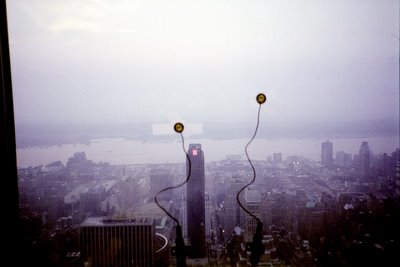 In 1999, New York-based sound artist Stephen Vitiello was awarded a five-month studio residency on the 91st floor of the World Trade Center. For his project World Trade Center Recordings: Winds After Hurricane Floyd, he taped contact mics to the studio windows, "picking up the sounds outside of passing planes, helicopters, storm clouds and traffic, the building itself swaying in the wind." You can listen to a short NPR piece about the project (and find other sounds here); meanwhile, Vitiello was recently interviewed in Artkrush, if you want a bit more information. But this reminds me of two other, related projects: 1) I read a review once in The Wire about a guy who taped contact mics to his window to record the sound of snowflakes hitting the glass – a recording which was then released on CD. Unfortunately, I can't find any information about this at all. 2) Extensive seismic readings were taken by Columbia University during the World Trade Center attacks of September 11th – the Precambrian bedrock of Manhattan was rumbling as the two towers collapsed, and this showed up on Columbia's seismometers. Sound artist Mark Bain then transformed this information into audio files, so you can actually listen to the wounded, melancholic howl of Manhattan as its two tallest buildings fall to the ground. Ultimately, Bain produced "a 74-minute recording of the ground vibrations of the World Trade Centre's collapse and contiguous mayhem," The Guardian writes. "It certainly does not make easy listening. The piece begins with a low, disconcerting rumble and proceeds through a range of fluctuating sounds. Bain says the vibration of the towers as they were hit by the hijacked passenger planes sounds like 'tuning forks'." He then seems quick to add that he "sees nothing morally questionable in making an artwork out of the event." "I guess I'm the black sheep," he says, "the anti-architect." If you have RealPlayer, you can download a 2-minute excerpt. Another vaguely related story, of course, is William Basinski... (This post was extensively updated on 26 January. For more on urban soundscapes see Orchestra of Bridges, London Instrument, Sound Dunes, and – an old favorite – musicalized weather events).
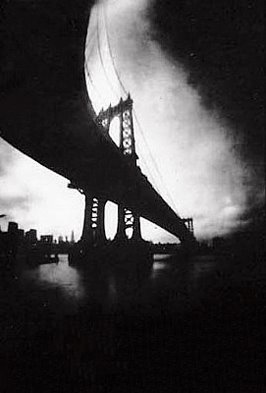 [Image: Michel Bayard]. Singing Bridges seeks to record, using contact microphones, the sounds of various bridges: stressed cables, rumbling footplates, geotechnical strain. It's all about playing "stay-cabled and suspension bridges as musical instruments." The artist's own justification for the project leaves a bit to be desired – claiming it has something to do with global information flow and Indra's Net – but the musicalization of urban infrastructure is something that totally fascinates me, and it's popped up on BLDGBLOG before. If we can go back to Coleridge for a second, and imagine him striding across the retractable bridges of Chicago, iPod in hand, plugging himself into the audial foundations of the city, the trembling of concrete and iron, how every atom vibrates, Aeolian, strummed by the world; or Coleridge wandering London, stepping onto the Thames foreshore, microphones ready, pushing away sand to record the passing of subterranean trains (or whalesong, for that matter); or, yet again, perhaps somewhere in the scoured volcanism of rural Iceland, contact mics taped down on the surface of the earth, Coleridge stands listening to the Atlantic expand, every subtle rumble of tectonic plates spreading; then the bridges of the world, specifically built for how they sound, humming in the wind, can join in – and it's worth considering that the vibrations of a bridge's pillars might record themselves in patterns in the subsurface soil, small figures of agitation inscribed into the earth, and that those might fossilize, and in a million years you'll have a musical score hardened into rock, sandstone evidence of how the earth once sounded, back then, which is now: a planet covered with bridges, vibrating in the wind. ( Singing Bridges spotted at Ruairi Glynn's excellent Interactive Architecture dot Org).
In a recent post I compared the fissured earth of Morocco's Atlas Mountains to the Grand Canyon.  Whether or not such a comparison holds – and I've received several opinionated emails either side – it's still interesting to speculate about the " peculiar geological circumstances surrounding the Grand Canyon" and whether they might be found elsewhere – even if that's a few hundred million years from now. As it happens, I'm reading Richard Fortey's fantastic new book Earth, and lo! He's been thinking what I'm thinking: "If we could wave a tectonic magic wand," he writes, "and gently elevate southern England, the River Thames would excavate a canyon of its own, another magnificent thing – and, deep enough, there would be the equivalent of the [Grand Canyon's] Vishnu schist. If we do the same in northern France, the Seine would carve through a sequence of hard and soft layers back to a deep and ancient metamorphic foundation. The same goes for Texas, or the Pirana Basin, or the Arabian Peninsula, or western Africa, or much of Siberia." There are Grand Canyons everywhere, in other words, waiting for the right conditions in which to form.  The question, then, is what can be done to further this process? Could we "gently elevate southern England," as Fortey says, perhaps learning from the project to lift Venice? Could we prop-up Texas on some oil derricks, for instance, moving those platforms further and deeper underneath the continental plate every year till the whole thing is an artificial Himalaya – then let the Rio Grande carve away? For that matter, could you perform an exact, laser-measured study of the internal volume of the Grand Canyon – then carve another one, in western China, or right in the heart of Greater London? Open a chain of hotels nearby, and you'd make all your money back through tourism. And geologists would love you. The world's first university-sponsored Grand Canyon. Harvard will buy it. Fortey himself compares the Grand Canyon to an act of carpentry: "The strata appear unwaveringly horizontal, like an infinity of stacked plywood worked with a giant fretsaw." So what are our geotechnical options here? How could we realize a world full of new Grand Canyons? (Earlier: sandblasting Manhattan into a new Arches National Park).
 There are about two dozen more of these images, taken during a trip through Morocco, September-October 2002, studies of light and proximity, architecture, routes and detours, space.  What I noticed in Marrakech almost immediately is that inside the networked markets that reflect one another through rows of glass lamps, bronze trinkets, polished rocks and small pieces of jewelry, laid out in tilted cases or stacked inside stalls, you find a collapse of expected proximities: everything's too close.  Toward the end of our trip, for instance, because of a gut parasite I'd picked up, I developed this insane fever that torqued the whole visual field into a funnel; then, while trying to figure out how I got that sick, we walked past a fruit stall – this was in Fes – immediately to the side of which, unprotected, out in the open, was a man taking a ball peen hammer to the skull of a dead cow, and chips of bone were flying everywhere, even landing on the fruit. People were buying the fruit, and serving it in restaurants. Everything was too close, in other words; hygiene and distance became unexpected synonyms.  What's interesting, though, is when you get out of the cities and into the desert, and a kind of hydro-topographical narrative begins: while there's water in the coastal plains, collecting in small valleys or oases, and supporting urbanization, as you pass away on looping roads into the hills the entire continental shield seems to dry out. The rocks are abstract and red; Mars conspiracists could probably argue NASA's rovers are actually tootling around in the iron-rich void of central Morocco. In any case, the continent is shattering; large rocks get smaller, weathered by thousands of years of wind and sandstorms – what Richard Fortey calls "the blast of erosion," in his awesomely great Earth – and you can actually watch as the terrain chips away at itself, getting closer and closer to the consistency of sand: sand which you then see on the horizon, in great dunes of the outer Sahara. Meanwhile, you've passed over massive fissures in the earth, the planet breaking open, and so the twisting claustrophobia of the urban market has been replaced by its apparent opposite: geological time, ripped open right in front of you in stratigraphic abysses that can rival the Grand Canyon. The continent is abrading to sand, there is no one in sight, the heat is amazing, and you've barely even set foot in the interior. But you realize that the complexity of the local architecture, especially in the markets and casbahs – which any labyrinth aficionado would fall in love with right away (I fell in love right away) – is not only a kind of terrestrial tactic, i.e. keeping small pieces of the planet (sand) out of the inner rooms, it's also a philosophical response to the utterly gigantic north African landscapes collapsing all over themselves, ground down to sandy fissures in the distance: you want to control space, and limit the perimeter. Keep the walls close. 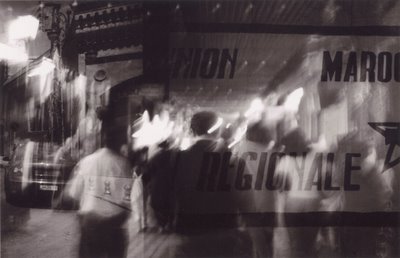 Whole rooms, entire buildings, seem to overlap with everything else – till it's like walking through double-exposures. (All images: Geoff Manaugh/BLDGBLOG; please link/credit if using elsewhere!)
"It's often hard to convince people that Olivo Barbieri's aerial photographs are real," Metropolis writes. 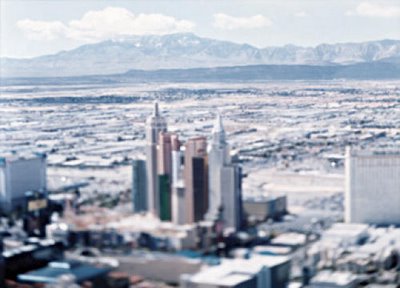 "They look uncannily like hyperdetailed models, absent the imperfections of reality. Streets are strangely clean, trees look plastic, and odd distortions of scale create the opposite effect of what we expect from aerial photography – a complete overview, like military surveillance." 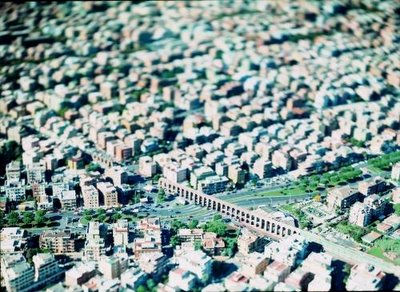 Barbieri "achieves the distinctive look by photographing from a helicopter using a tilt-shift lens – a method, he says, that 'allows me to choose what I really like in focus: like in a written page, we don't read [it as an] image but one line at a time.'" It's geology disguised as sculpted chocolate; a Claymation paradise. Herculean examples of American civic infrastructure look like nothing more than cardboard, flimsy and ridiculous. (Amazingly, the second image, below, is a photograph of Hoover Dam).  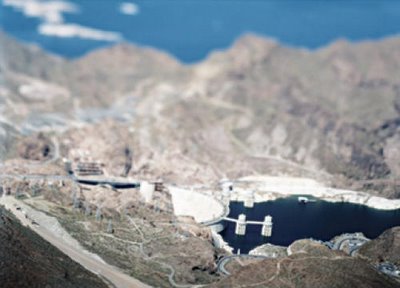 "For Barbieri," Metropolis says, "it is 'the city as an avatar of itself.'" So if he did take photos of city models someday... would they look real? 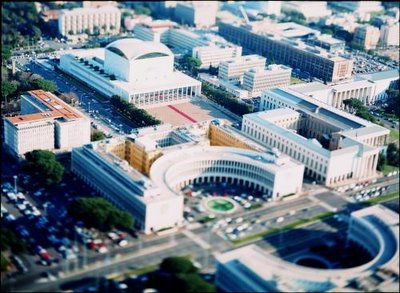 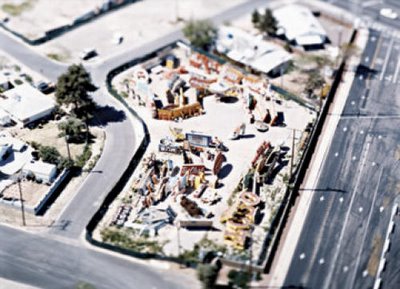 I'm left wondering what this techique would achieve in the field of human portraiture. The blurred heads of Francis Bacon meet some kind of plasticized mannequinization of the subject... Pickman's Model. The results could be horrific. (See also BLDGBLOG's look at the work of Oliver Boberg; and click here for another photo by Barbieri. Meanwhile, thanks to Brent Kissel for the initiating email! Thanks, as well, to Dan who I think might have mentioned Barbieri once...).
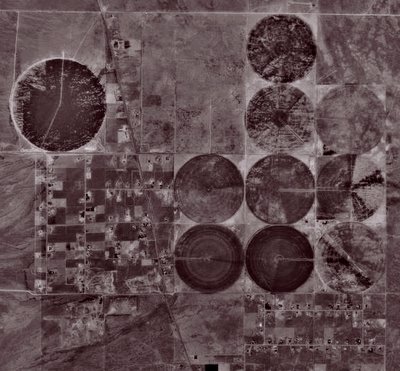 [Image: Irrigated geometries of the American West, courtesy of TerraServer].
 A composite of riverine meanders, ancient hydrological scars in the earth of California, Owens Valley, like glimpses of old Chinese landscape scrolls – 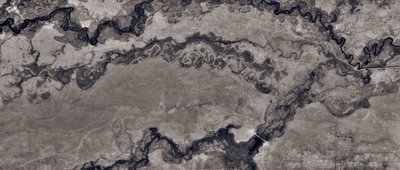 – taken from the satellites of TerraServer. Fossilized wakes and side-streams, eroding banks of fractal continents. Silt on silt. Everything ending in self-similarity. 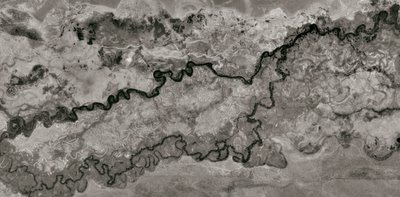 Click-on to enlarge! Please! Meanwhile, see Pruned's uploaded set of geological investigations from the lower Mississippi alluvial basin.
 As the above text describes – and as you can read here – architect Chris Hardwicke has recently proposed a network of elevated bike trails – glass tunnels soaring above Toronto, in a "dynamic air circulation loop" – that would allow city residents to travel by bicycle at speeds of up to 40kph. It would look like this:  Two thoughts: 1) the Tour de France of the future will be a Tour de Sky Tunnels of Toronto; and 2) why not build a moving version, nomadic, hinged, flexible, a kind of glass octopus of dynamic sky-routes, accessible only by pedestrians, going nowhere except into itself, knot-like, a mobile marathon route torquing above the city at night, reflective, looping over Roncesvalles, utopian junctions in space? (Spotted at Archinect).
 [Image: A repositioned image from TerraServer of a motorway interchange in Lynwood, California. It could almost be a set for Léger's Ballet méchanique (whose music is intriguingly described here). See earlier].
I just saw this at Tropolism, and was amazed: turning abandoned buildings – into sculptures.   Would you still be able to use those rooms?, I wonder. To work in them and go to sleep in them and take stairways up the legs between levels? All the while living inside this Empire Strikes Back/robotect sculpture? The head, for instance, could be rented out as a two-bedroom flat... "As each vacated building is subsequently recycled and transformed into a sculpture," the architects write, "abandonment and demolition is no longer viewed as a negative process but becomes a celebration for cultural creation, urban revitalization, and identity building." 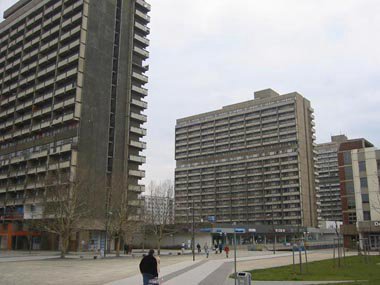 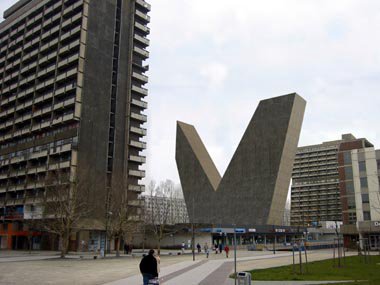 What other sculptures of I-beams and rebarred floor plates exist within skyscrapers, from London to Chicago, LA to Beijing? A selective pruning of a high-rise's insides, and a new skyline takes shape, pierced by breezes. Which leads me to wonder if you could sandblast all the buildings of Manhattan into rounded landscape sculptures, rock, brick, glass, and steel ground down to geometric smoothness. Aerodynamic. Like a rock-tumbler, turning backyard gravel into perfect spheres, eggs, and ovals, could you polish the city down to a gleaming rock park of half-abraded office towers, adjoined buildings sanded one into the another like the lips of wooden bowls – just throw the whole island into a rock-tumbler? Sandblast new sculptures out of every brownstone. Or could you declare war on a city not with bombs and missiles but with high-powered industrial abraders and sandblasting machines? Turn Manhattan into a smooth series of sandstone arches and contours, all of New York a hulking Utah-like world of "balanced rocks, fins and pinnacles... highlighted by a striking environment of contrasting colors, landforms and textures"? 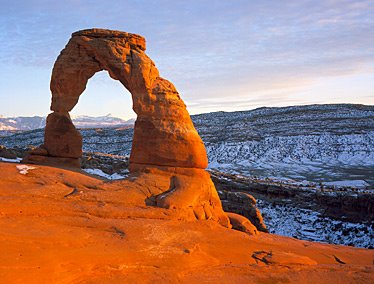 It's Arches National Park: Manhattan Branch. All that bedrock, geology and form released – by the geotechnical avant-garde. City sculptors. Sandblasting the torqued ruins of Manhattan; then moving back to re-colonize those polished canyons. 
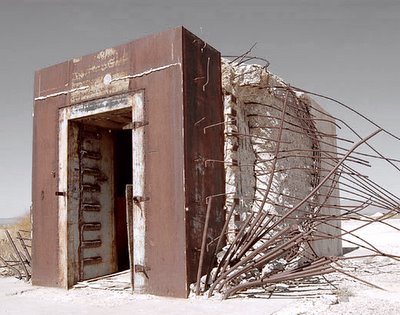 "Within a large concrete room, hewn out of a mountain on a freezing-cold island just 1000 kilometres from the North Pole, could lie the future of humanity. The room is a ' doomsday vault' designed to hold around 2 million seeds, representing all known varieties of the world's crops. It is being built to safeguard the world's food supply against nuclear war, climate change, terrorism, rising sea levels, earthquakes and the ensuing collapse of electricity supplies." And I'm on my way... "The $3 million vault" – which seems a remarkably cheap price to "safeguard the world's food supply" – "will be built deep inside a sandstone mountain lined with permafrost on the Norwegian Arctic island of Spitsbergen. The vault will have metre-thick walls of reinforced concrete and will be protected behind two airlocks and high-security blast-proof doors. It will not be permanently manned, but 'the mountains are patrolled by polar bears', says [Cary Fowler, director of the Global Crop Diversity Trust, an independent international organisation promoting the project]." "This will be the world's most secure gene bank by some orders of magnitude," says Fowler. Rumors are the vault was designed by Jerry Bruckheimer – and it's not seeds they're keeping in there... but Noah's Ark. Wait – (A somewhat related, and very interesting, story: global seed-hunters, as reported in The Guardian).
 [Image: Banksy (Marble Arch, London, 2004); via Enjoy Surveillance]. "Residents of a trendy London neighbourhood are to become the first in Britain to receive ' Asbo TV' – television beamed live to their homes from CCTV cameras on the surrounding streets. As part of the £12m scheme funded by the Office of the Deputy Prime Minister," the Times reports, "residents of Shoreditch in the East End will also be able to compare characters they see behaving suspiciously with an on-screen 'rogues’ gallery' of local recipients of anti-social behaviour orders (Asbos)." This is part of a "New Deal for Communities to regenerate poor districts" – by watching those districts on TV. It's the future of televised entertainment. So will advertisers buy every wall in view of a camera...? (For more, see BLDGBLOG's earlier piece on CCTV and urban psychovideography; as well as a quick post on wmmna).
|
|



 [Images: The concrete skeleton of Libya's future river, the "8th wonder of the world," being trucked into place; photographed by Jaap Berk].
[Images: The concrete skeleton of Libya's future river, the "8th wonder of the world," being trucked into place; photographed by Jaap Berk].


 [Image: A new river is born, excavated from the surface of the desert: soon the pipes will be installed and the currents will start to flow...].
[Image: A new river is born, excavated from the surface of the desert: soon the pipes will be installed and the currents will start to flow...].














































